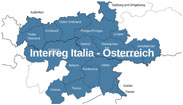Cross-border cooperation in the programming period 2021-2027
For the forthcoming long-term budget of the European Union from 2021 to 2027, the European Commission proposes to modernise cohesion policy. Cohesion policy is the most important investment policy of the EU and an extremely concrete expression of its solidarity, because it supports the European Community in overcoming structural and social differences between the member states, but also within the individual states. These differences damage economic and social cohesion within the European Union and only by overcoming them can our Union develop in a harmonious, balanced and sustainable way. In order to achieve this, cohesion policy is implemented through special financial instruments, the so-called European Structural Funds. These structural funds also include the Interreg programmes and thus also the Interreg Italy-Austria programme.
The draft strategy for the Interreg VI Italy-Austria 2021-2027 programme is drafted on the basis of the following three inputs:
1. Five objectives of cohesion policy
With the new cohesion policy, the European Commission is focusing on the following five investment priorities:
- a smarter Europe through innovation, digitisation, economic change and support for small and medium-sized enterprises
- a greener, CO2-free Europe that implements the Paris Convention and invests in energy transformation, renewable energies and the fight against climate change
- a more interconnected Europe with strategic transport and digital networks
- a more social Europe that implements the European pillar of social rights and promotes quality jobs, education, skills, social inclusion and equality of access to health care
- a Europe closer to its citizens by supporting local development strategies and sustainable urban development across the EU
2. Task Force for Programming 2021+
At the meeting of the Monitoring Committee held in Salzburg on 9 May 2019, the managing authority of the Interreg Italy-Austria programme was mandated to initiate preparations for the next programme period. The technical meetings of the "Task Force on Programming 2021+", composed of representatives of the programme regions and the Member States, will be used to prepare the new programme. Innovations and optimisations of the strategy will be developed jointly on the basis of the experience gained during the funding period which is coming to an end and the new needs of the programme regions. The Task Force meets approximately every 6 weeks.
3. Public consultations of interested parties
Public opinion plays a key role in defining the new programme strategy. In various consultations, the views, expectations and suggestions of stakeholders, i.e. past and future promoters, but also of the general public are sought. All information and invitations to these consultations are available on this website.
Priorität
Die Strategie Interreg VI-A Italien-Österreich 2021-2027 wurde auf der Grundlage der Ziele und Anforderungen der Europäischen Kommission sowie von öffentlichen Konsultationen und Analysen der Bedürfnisse, Möglichkeiten, Herausforderungen, Stärken und Schwächen im Programmgebiet entwickelt (s.u.). Auf dieser Basis wurden fünf Prioritäten festgelegt, in deren Rahmen das Kooperationsprogramm grenzüberschreitende Projekte unterstützen wird.
First consultation of interested parties
As part of the programming of the future cooperation programme Interreg Italy-Austria 2021-27, a questionnaire has been published to collect strategic contributions. It was addressed to all Stakeholders within and outside the programme and was could be answered online from December 2019 to January 2020. Among other things, the questionnaire asked about the central areas of interest and the added value of crossborder cooperation, the experiences of the past programme and the expectations of the new one, as well as an assessment of the relevance of the various political objectives of the new agenda for Europe, such as a more intelligent Europe, a greener Europe or a more social Europe.
The results of the consultation are currently being evaluated and will be published here shortly.
Programmbehörden
Um ein effizientes Management und eine erfolgreiche Umsetzung des KP Interreg V-A Italien-Österreich 2014-2020 zu gewährleisten, verfügt das Programm über folgende Organisationsstrukturen.
Verwaltungsbehörde – VB
Die Verwaltungsbehörde trägt die Verantwortung für die Verwaltung, die Umsetzung und das Monitoring des Programms. Sie ist die Schnittstelle zwischen Europäischen Kommission und den Programmregionen. Sie schließt den Interreg-Fördervertrag mit den Lead Partnern ab.
Regionale Koordinierungsstellen – RK
In jeder Programmregion gibt es eine Regionale Koordinierungsstelle, die als Bindeglied zwischen den Programmbehörden und den Begünstigten als erste Anlaufstelle für potentielle Antragsteller fungiert. Die RK überprüfen die Synergien der Projekte mit den Landes- und Regionalpolitiken und -strategien.
Gemeinsames Sekretariat – GS
Das Gemeinsame Sekretariat ist am Sitz der Verwaltungsbehörde eingerichtet und unterstützt alle Programmbehörden und -ausschüsse bei der Wahrnehmung ihrer Aufgaben und die Projektträger bei allen verwaltungstechnischen Angelegenheiten der Projektumsetzung.
Kontrolle erster Ebene - FLC
Jeder RK gehört eine Kontrollinstanz an, welche mit der Kontrolle erster Ebene, bzw. First Level Control, beauftragt ist. In dieser Kontrolle werden die von den Begünstigten getätigten Kosten kontrolliert.
Prüfbehörde – PB
Die Prüfbehörde prüft in der Kontrolle zweiter Ebene (SLC) die Gewährleistung einer effizienten Funktionsweise des Verwaltungs- und Kontrollsystems und stellt sicher, dass die Prüfaktivitäten von VB und BB geeignet sind für die Überprüfung der erklärten Ausgaben.
Lenkungsausschuss – LA
Der Lenkungsausschuss setzt sich aus Vertretern der Programmregionen zusammen. Die Vertreter der beiden Mitgliedsstaaten haben eine beobachtende Funktion. Die Hauptaufgabe des Lenkungsausschusses ist die Auswahl der förderfähigen Projekte.
Begleitausschuss – BA
Im Begleitausschuss sind u. a. die Mitgliedstaaten, die Umweltbehörden, die Vertreter der Wirtschafts- und Sozialpartner, der Chancengleichheit und Lokalkörperschaften und die Programmregionen vertreten. Die Europäische Kommission hat eine beratende Funktion. Der BA garantiert die die Qualität der Durchführung des Programms.
